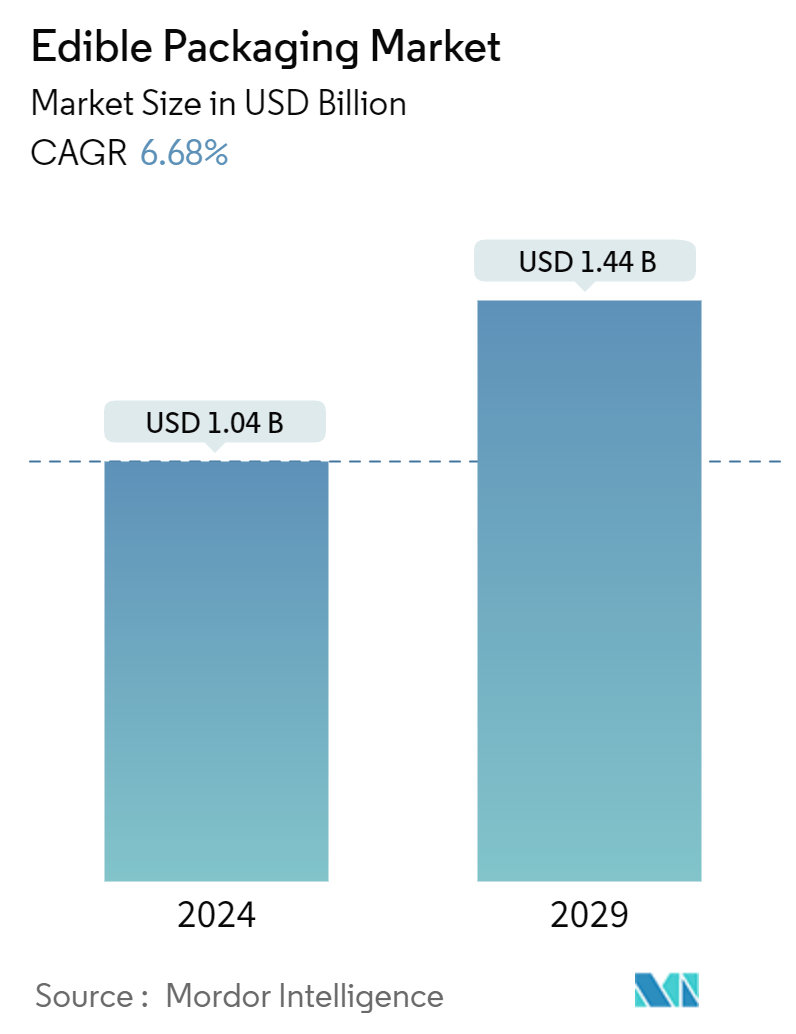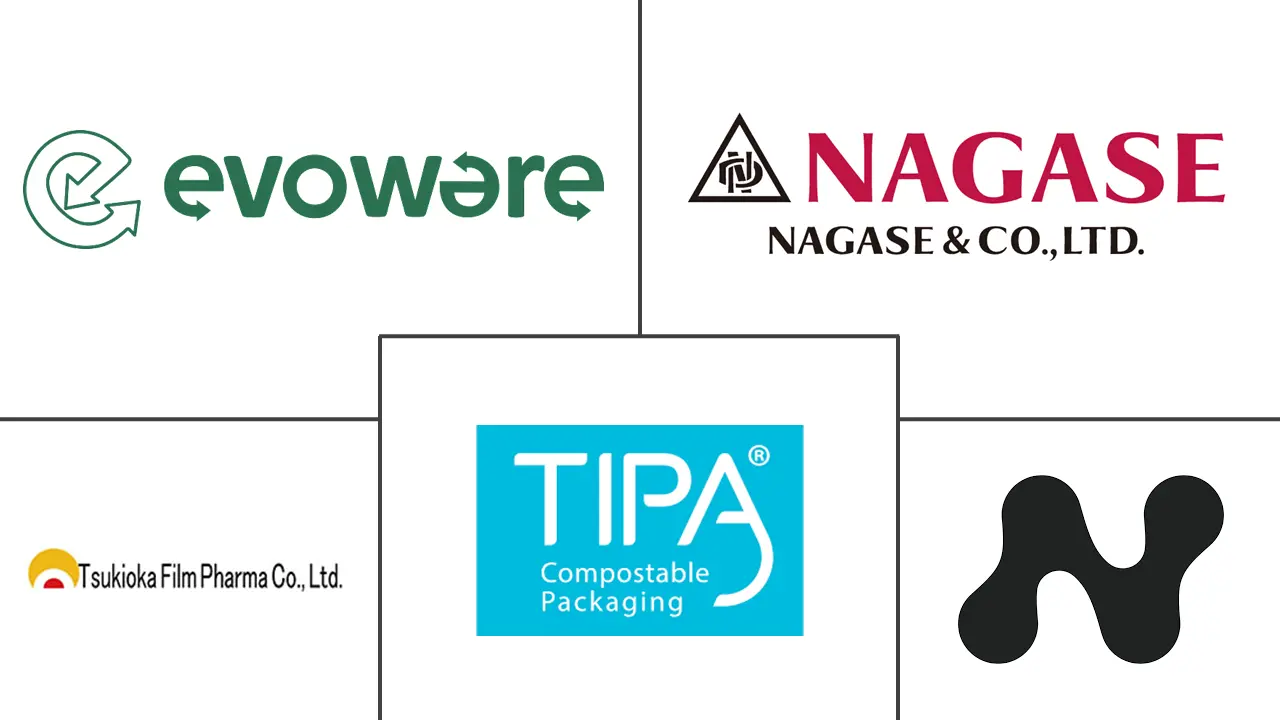Market Size of Edible Packaging Industry

| Study Period | 2019 - 2029 |
| Market Size (2024) | USD 1.04 Billion |
| Market Size (2029) | USD 1.44 Billion |
| CAGR (2024 - 2029) | 6.68 % |
| Fastest Growing Market | Europe |
| Largest Market | North America |
Major Players
*Disclaimer: Major Players sorted in no particular order |
Edible Packaging Market Analysis
The Edible Packaging Market size is estimated at USD 1.04 billion in 2024, and is expected to reach USD 1.44 billion by 2029, growing at a CAGR of 6.68% during the forecast period (2024-2029).
• Edible packaging, made from plant-based ingredients, can be eaten directly, eliminating the need to process or recycle. With more people caring about the environment, this new type of packaging is an excellent alternative to traditional options. It meets the demand for eco-friendly products and helps reduce waste in landfills.
• Edible packaging protects food from carbon dioxide, fats, moisture, oxygen, and smells. It keeps food fresh and extends its shelf life. One significant advantage is that it can include various active ingredients that improve food safety and nutrition. Edible packaging materials include soybean protein, wheat gluten, whey, and gelatine, attracting businesses to invest in this area.
• In October 2023, Gousto (SCA Investments Limited) introduced the world's first edible pea protein-based packaging, developed with Xampla, a spinout from Cambridge University. This packaging works like plastic, preserving food taste and shelf life, but it is vegan, gluten-free, and eco-friendly.
• Governments and major manufacturers are investing in edible packaging for food and pharmaceutical products. For example, the U.S. Department of Agriculture and the American Chemical Society are developing edible packaging from casein, a milk protein film. This material is 500 times better at protecting food from oxygen.
• With the global ban on plastic, eco-friendly options like edible bags, straws, and containers are becoming more popular. This has increased demand and growth in the packaging sector. Companies making edible products are expanding to meet this demand, leading to more investments in the field.
• A Non-Resident Indian (NRI) from Mangalore, based in Qatar, has created EnviGreen, an eco-friendly carrier bag. These bags look like plastic but are made from natural starch and vegetable oil derivatives. They dissolve in room-temperature water within a day and in boiling water within 15 seconds. Such innovations are expected to boost market demand in the coming years.
• However, edible packaging is more expensive to produce than traditional packaging. The higher cost and the need for secondary packaging to protect against contamination are challenges for the market. Manufacturers have to spend more on protective measures, increasing overall packaging costs.
Edible Packaging Industry Segmentation
Edible packaging is a sustainable solution designed to be eaten or biodegraded, commonly made from plant- or animal-based sources. Edible packaging works as an alternative to plastic packaging and helps reduce plastic waste as everything is eaten or biodegraded. It helps reduce waste and reduces the need for recycling. Continuous research and development (R&D) are carried out by the vendors operating in the market to offer better product offerings adhering to the end-user industry requirement. The edible packaging market is expected to experience more innovation in the coming years, and mergers and acquisitions are expected in the industry. New brands have gained traction in the last few years due to the quality of their offerings.
The edible packaging market is segmented by source (plant and animal), raw material (protein, polysaccharides, lipids, and other raw materials), end-user industry (food, beverage, and pharmaceutical), and Geography (North America [United States and Canada], Europe [Germany, United Kingdom, France, Italy, and Rest of Europe], Asia-Pacific [China, Japan, India, Australia and New Zealand, and Rest of Asia Pacific], Latin America, Middle East and Africa). The report offers market forecasts and size in value (USD) for all the above segments.
| By Source | |
| Plant | |
| Animal |
| By Raw Material | |
| Protein | |
| Polysaccharides | |
| Lipids | |
| Other Raw Materials |
| By End-User Industry | |
| Food | |
| Bevergae | |
| Pharmaceutical |
| By Region | ||||||
| ||||||
| ||||||
| ||||||
| Latin America | ||||||
| Middle East and Africa |
Edible Packaging Market Size Summary
The edible packaging market is experiencing significant growth, driven by increasing consumer demand for sustainable and eco-friendly packaging solutions. This innovative packaging, made from plant-based ingredients, offers a direct alternative to traditional packaging by being consumable and reducing landfill waste. The market is gaining traction as it addresses environmental concerns and aligns with the global shift towards biodegradable and renewable materials. Companies are investing in research and development to create packaging that not only preserves food but also enhances its safety and nutritional value. The introduction of products like pea protein-based packaging and seaweed-based coatings highlights the industry's commitment to sustainability and innovation.
Despite the promising growth prospects, the edible packaging market faces challenges such as higher production costs compared to conventional packaging and the need for additional protective measures to prevent contamination. However, the increasing consumer willingness to pay for sustainable options and the regulatory push against single-use plastics are fostering a conducive environment for market expansion. Key players in the market are focusing on expanding their presence and developing new technologies to capture a larger market share. The market's semi-consolidated nature, with a few dominant players, is expected to evolve as more companies enter the space, driven by the growing demand for environmentally friendly packaging solutions.
Edible Packaging Market Size - Table of Contents
-
1. MARKET INSIGHTS
-
1.1 Market Overview
-
1.2 Industry Attractiveness - Porter's Five Forces Analysis
-
1.2.1 Bargaining Power of Suppliers
-
1.2.2 Bargaining Power of Buyers
-
1.2.3 Threat of New Entrants
-
1.2.4 Threat of Substitutes
-
1.2.5 Intensity of Competitive Rivalry
-
-
1.3 Industry Value Chain Analysis
-
-
2. MARKET SEGMENTATION
-
2.1 By Source
-
2.1.1 Plant
-
2.1.2 Animal
-
-
2.2 By Raw Material
-
2.2.1 Protein
-
2.2.2 Polysaccharides
-
2.2.3 Lipids
-
2.2.4 Other Raw Materials
-
-
2.3 By End-User Industry
-
2.3.1 Food
-
2.3.2 Bevergae
-
2.3.3 Pharmaceutical
-
-
2.4 By Region
-
2.4.1 North America
-
2.4.1.1 United States
-
2.4.1.2 Canada
-
-
2.4.2 Europe
-
2.4.2.1 Germany
-
2.4.2.2 United Kingdom
-
2.4.2.3 France
-
2.4.2.4 Italy
-
-
2.4.3 Asia-Pacific
-
2.4.3.1 China
-
2.4.3.2 Japan
-
2.4.3.3 India
-
2.4.3.4 Australia and New Zealand
-
-
2.4.4 Latin America
-
2.4.5 Middle East and Africa
-
-
Edible Packaging Market Size FAQs
How big is the Edible Packaging Market?
The Edible Packaging Market size is expected to reach USD 1.04 billion in 2024 and grow at a CAGR of 6.68% to reach USD 1.44 billion by 2029.
What is the current Edible Packaging Market size?
In 2024, the Edible Packaging Market size is expected to reach USD 1.04 billion.

